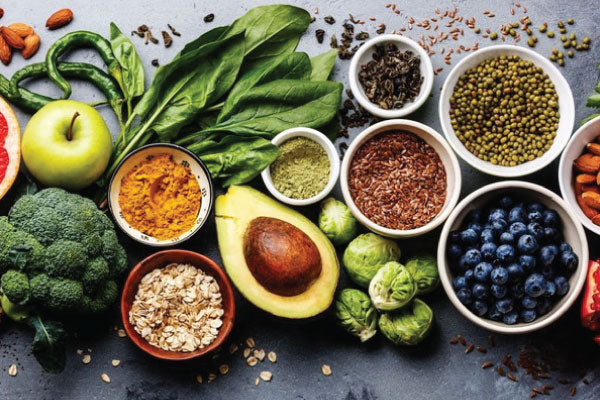Finding lasting relief for your aching fingers starts with knowing exactly why they're hurting. The discomfort you feel is almost always down to one of two main culprits, and figuring out which one you’re dealing with is the first step toward getting the right kind of help.
Understanding What Causes Your Finger Pain
Think of the pain as a signal. Once you learn to interpret what your body is telling you, you're in a much better position to manage it. While a few different things can cause sore joints, for persistent finger pain, it usually boils down to two types of arthritis.
And it’s a massive issue here in the UK. We're talking about 10 million people living with some form of arthritis, making it one of the most common chronic conditions in the country. That's a lot of people looking for answers, which is why getting to the root of the problem is so important.
The 'Wear-and-Tear' Type: Osteoarthritis
Osteoarthritis, or OA, is the one you hear about most often. It's often called "wear-and-tear" arthritis, which is a pretty good description of what’s happening.
Picture the cartilage in your finger joints as smooth, protective caps on the ends of your bones. Over many years of use, this cushioning can start to wear thin. Eventually, the bones can end up rubbing directly against each other. That friction is what causes the familiar stiffness, aching, and pain, especially after a busy day in the garden or a long session of typing.
The Autoimmune Attacker: Rheumatoid Arthritis
Rheumatoid Arthritis (RA) is a completely different beast. This is an autoimmune condition, which means your own immune system gets confused and starts attacking the lining of your joints (the synovium).
This misguided attack triggers a whole lot of inflammation, leading to the swelling, warmth, and intense pain characteristic of RA.
Unlike the slow, gradual wear of OA, RA inflammation can be aggressive and pop up in painful flare-ups that might last for weeks or even months. It's this inflammatory process that, if left unchecked, can lead to more serious joint damage.
This handy infographic gives you a quick look at how common each type is and how they differ in one key symptom: morning stiffness.
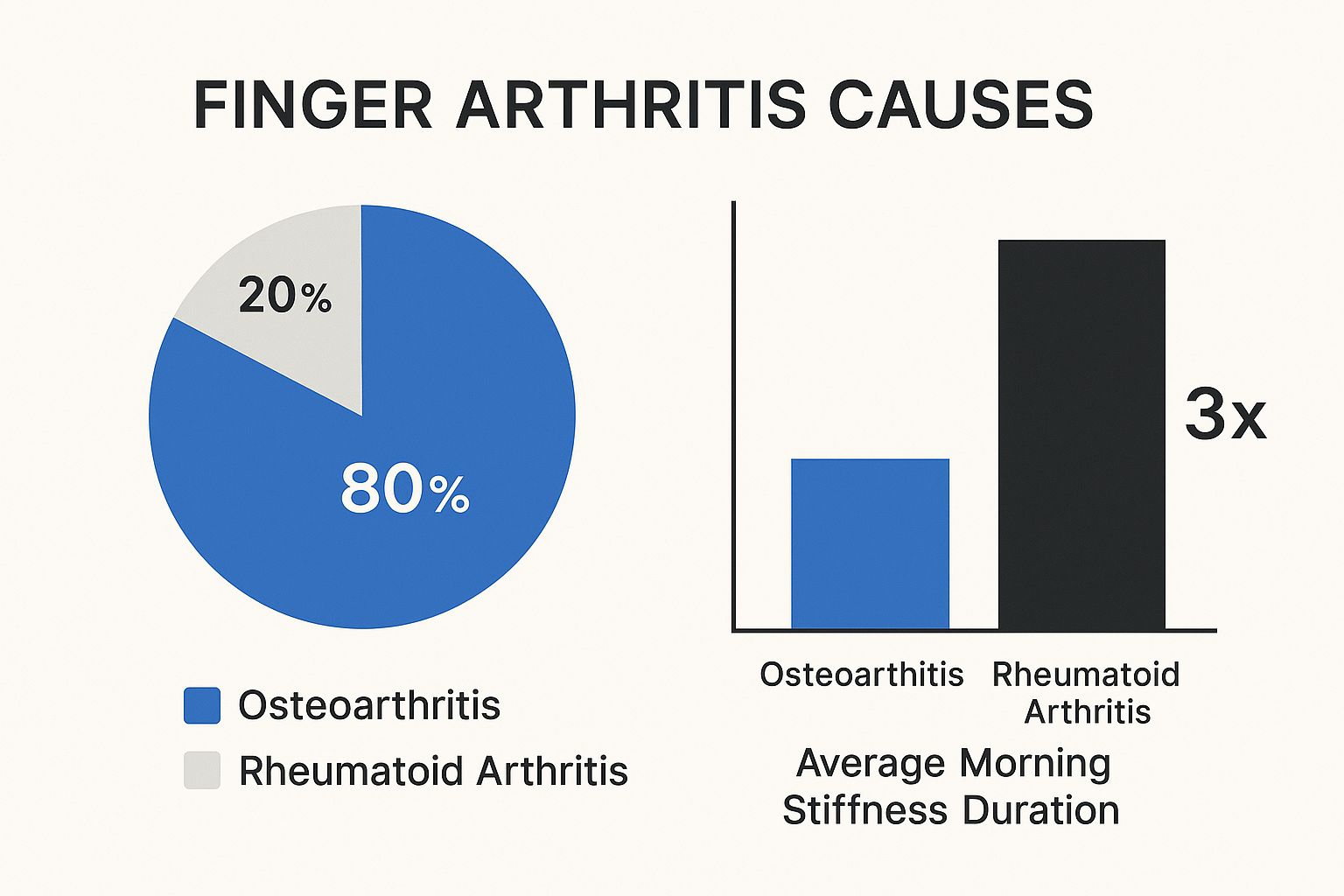
As you can see, OA is much more widespread. But the long-lasting morning stiffness that comes with RA is a dead giveaway of its inflammatory nature. Getting a handle on that inflammation is absolutely key. For a deeper dive, check out our guide on the signs of chronic inflammation to better understand your body’s signals.
To help you tell the difference, here's a quick comparison of how the two conditions typically show up in the fingers.
Osteoarthritis vs Rheumatoid Arthritis in Fingers
| Feature | Osteoarthritis (OA) | Rheumatoid Arthritis (RA) |
|---|---|---|
| Primary Cause | Mechanical wear and tear on cartilage over time. | Autoimmune response attacking the joint lining. |
| Affected Joints | Often starts in the joints closest to the fingertips and at the base of the thumb. Usually affects one side more than the other. | Typically affects the knuckles and middle joints of the fingers, often symmetrically on both hands. |
| Morning Stiffness | Usually lasts less than 30 minutes. | Often lasts for more than an hour, sometimes much longer. |
| Symptoms | Aching, bony knobs (nodes) on finger joints, reduced range of motion. | Swelling, warmth, redness, pain, and tenderness. Flare-ups are common. |
| Systemic Effects | Limited to the joints. | Can affect the whole body, causing fatigue, fever, and loss of appetite. |
Of course, the only way to know for sure is to get a proper diagnosis from your doctor. Once you're clear on whether you’re dealing with OA or RA, you can start building a targeted plan for relief that actually works.
Gentle Exercises to Restore Finger Mobility
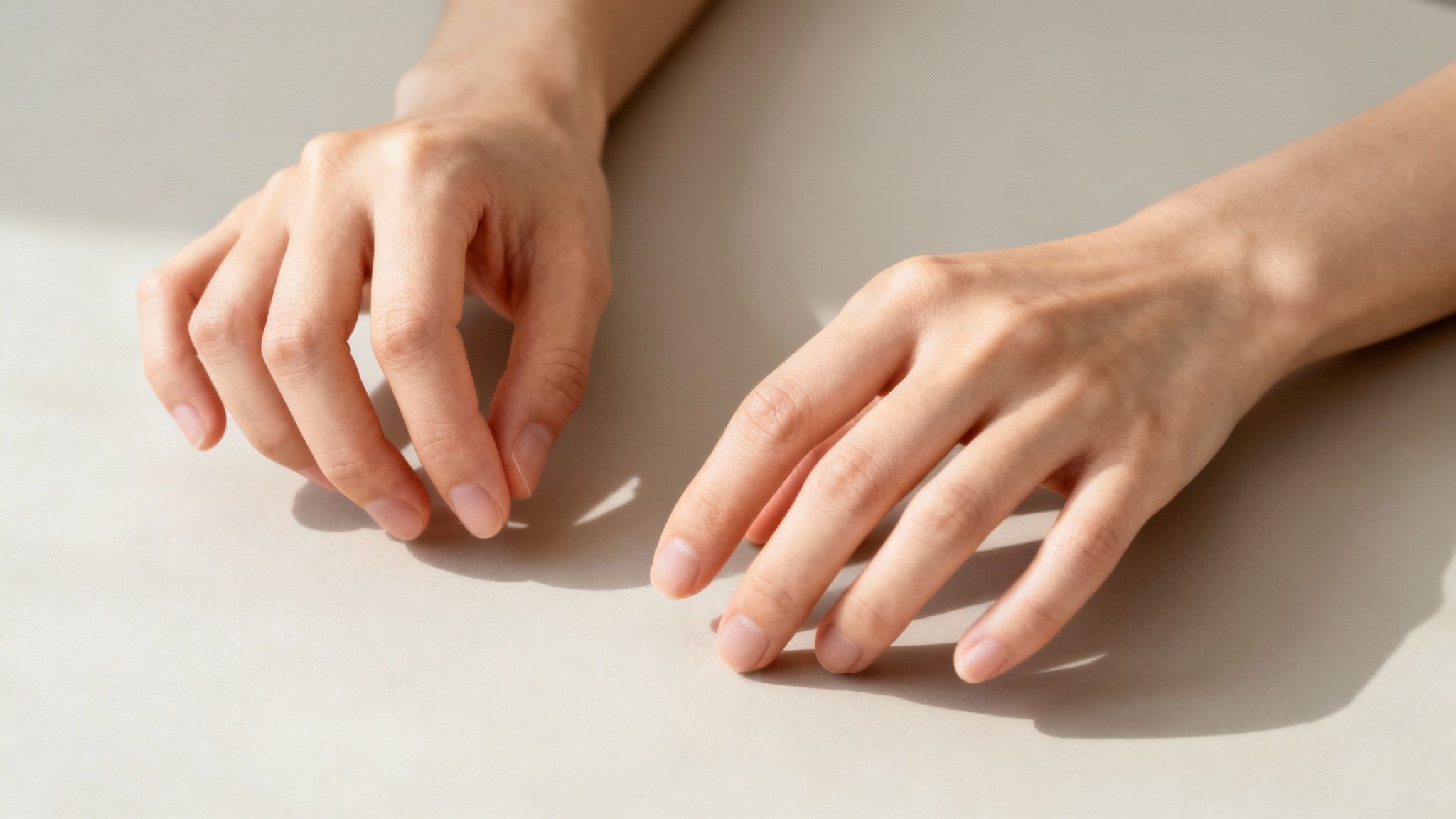
When your fingers are aching, the last thing you probably want to do is move them. I get it. It seems completely backwards. But here's the thing: the right kind of gentle, targeted movement is one of the best things you can do for lasting relief from arthritis in your fingers.
The secret is to focus on exercises that boost flexibility and cut down on stiffness, without piling more strain onto your already sensitive joints.
Think of it as lubricating your joints from the inside out. This kind of regular, controlled motion helps keep your remaining cartilage healthy and gets the blood flowing, which can dial down the pain and improve how well you can move. For many people I've spoken to, doing these first thing in the morning is an absolute game-changer for tackling that awful morning stiffness.
Foundational Movements for Finger Flexibility
Getting started is easy, and you don't need any fancy equipment. The real goal here is consistency, not trying to push through the pain. Just a few minutes every day can add up to a massive difference over time.
Begin with these core exercises. Remember to perform them slowly and with intention.
- Slow Fist Making: Start with your hand open, fingers nice and straight. Gently and slowly, curl your fingers into a loose fist, letting your thumb rest on the outside. Hold it for a few seconds, then just as slowly, uncurl your fingers back to the start. Aim for 5-10 repetitions on each hand.
- Finger Bends: Hold your hand out so your palm is facing you. One by one, bend each finger down to touch the top of your palm. Try to hold each bend for about 3-5 seconds before straightening it out again. Once you’ve done each finger, that’s one set.
- Thumb Touches: With your palm open, stretch your thumb across to touch the very tip of your little finger. If you can't quite reach, don't worry about it – just go as far as feels comfortable. Hold for a moment, then return. Repeat this, touching your thumb to each of the other fingertips on that hand.
Here's the golden rule for any therapeutic exercise: it should never cause sharp pain. A bit of a gentle stretch is perfectly fine, but if you feel anything sharp or sudden, ease off immediately. Your body knows its limits, so it's important to listen to it.
Mastering Safe and Effective Technique
To really get the benefits and avoid making things worse, how you do these exercises is just as important as what you're doing. Rushing through the movements or pushing your joints further than they want to go can easily backfire, leading to more inflammation and discomfort.
Listening to your body is crucial. On days where the pain is a bit louder, you might need to do fewer repetitions or just stick to the simplest, gentlest movements. The whole point is to build a routine you can stick with for the long haul.
A common mistake I see is people forgetting to warm up. Before you start, try soaking your hands in a bowl of warm water for five or ten minutes. It's such a simple step, but it relaxes the muscles and tendons, making every movement that much smoother and more comfortable. It’s a small time investment that pays off big time in pain-free mobility.
Practical Home Remedies That Actually Work
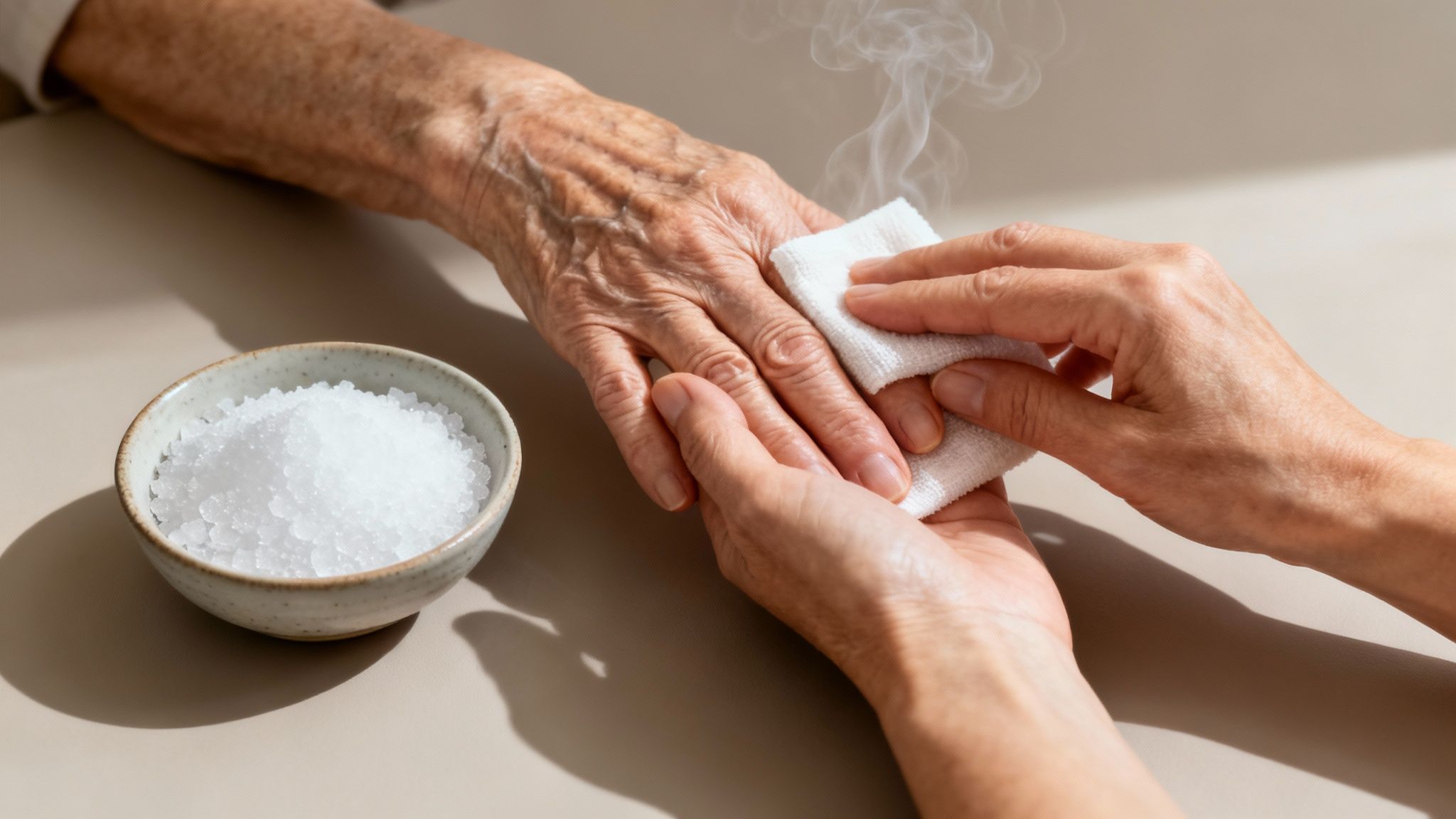
While the right exercises are a brilliant foundation for managing arthritis, you don't always need complicated routines to get relief. Your own home is full of simple, yet incredibly effective, tools for tackling the daily aches and stiffness that can really get in the way of things.
The trick is knowing how to use these remedies when your body needs them most. It’s not just about what you use, but learning to listen to your body’s signals and responding in the moment. This is how you start to feel more in control of your symptoms, day in and day out.
Mastering Heat and Cold Therapy
One of the most powerful and readily available methods is playing with temperature—using both heat and cold. They do very different jobs, so knowing which one to reach for is the key to getting the results you want.
-
Warmth for Stiffness: Heat is your best friend when your fingers feel stiff and achy, especially first thing in the morning. A warm compress, a soak in a bowl of warm water, or even a paraffin wax bath can feel like a miracle. The warmth boosts blood flow, helping to relax those tight muscles and ease that deep, nagging ache.
-
Cold for Inflammation: On the other hand, after a busy day using your hands or during a painful flare-up where you notice swelling and a sharp sting, it’s time for cold. A small ice pack or even a bag of frozen peas wrapped in a tea towel is perfect. Cold helps to constrict the blood vessels, which brings down swelling and numbs those sharp pain signals.
A good rule of thumb for both is to apply for 15-20 minutes at a time, making sure to give your skin a break in between. It's really important never to put extreme heat or ice directly onto your skin.
Soothing Soaks and Topical Support
Beyond just hot and cold, a few other simple remedies can offer a world of comfort. An Epsom salt soak, for instance, is a classic for a very good reason. The magnesium in the salts is brilliant for helping to ease muscle tension and reduce pain. Just dissolve a couple of tablespoons in a bowl of warm water and soak your hands for 15 minutes—it can be incredibly calming.
Topical creams and gels also give you the ability to deliver relief right to the source of the pain. You can find plenty of effective options over the counter, with ingredients like capsaicin, which creates a warming feeling that helps to block pain signals. For those interested in more natural options, our CBD Topical Guide is a great resource for understanding how these products can offer targeted support for skin and joints.
These at-home strategies are a vital part of managing daily symptoms. The widespread nature of arthritis in the UK underscores their importance; in 2022-2023, over 30 million prescriptions for musculoskeletal conditions were dispensed in England alone, costing around £139 million. This highlights the ongoing need for accessible, effective relief. You can explore more about these figures and their impact by checking out the State of Musculoskeletal Health report.
Everyday Lifestyle Changes for Lasting Comfort
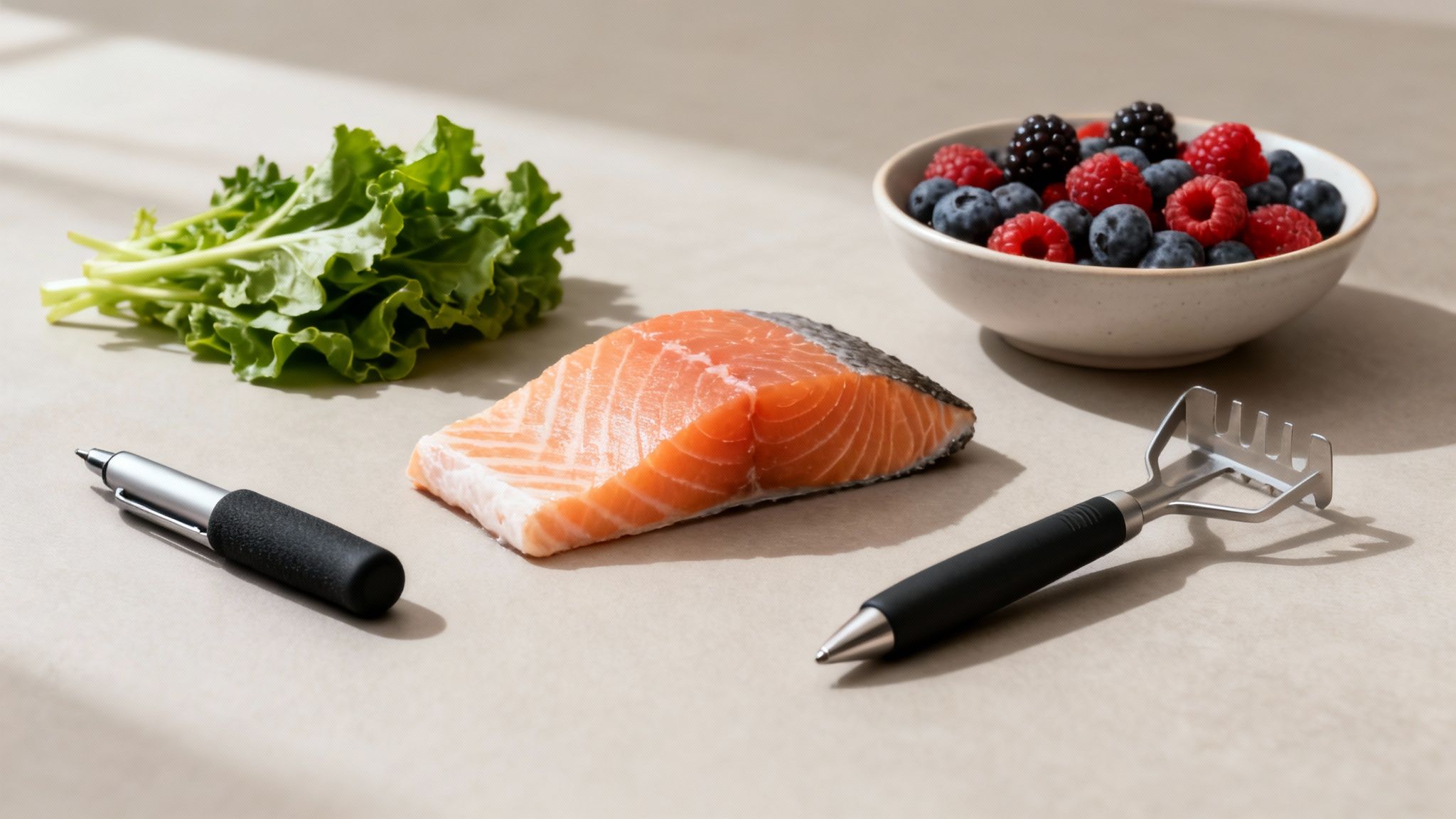
Real, long-term relief from arthritis in your fingers isn't just about what you do when the pain flares up. It's about weaving smarter habits into your daily life. Think of it as creating an environment where your joints are supported, not stressed.
These small but meaningful shifts can drastically reduce the strain on your finger joints, helping to keep those painful flare-ups at bay. By being more mindful of what you eat and how you tackle everyday tasks, you build a much stronger defence against that persistent ache.
Embrace Anti-Inflammatory Eating
It's a simple truth: the food on your plate can either fan the flames of inflammation or help to calm them down. Shifting your diet is a fantastic way to manage arthritis symptoms from the inside out. This isn't about deprivation; it's about crowding out the bad with more of the good.
Focus on foods that are brimming with anti-inflammatory compounds like omega-3 fatty acids and antioxidants. These are the nutritional heroes in the fight against joint pain.
Here's a quick look at some of the best foods to add to your shopping list.
Anti-Inflammatory Foods for Joint Health
| Food Category | Examples | How It Helps |
|---|---|---|
| Fatty Fish | Salmon, mackerel, sardines, anchovies | Packed with omega-3 fatty acids that directly combat inflammatory processes in the body. |
| Berries & Cherries | Blueberries, strawberries, raspberries, tart cherries | Loaded with antioxidants called anthocyanins, which have potent anti-inflammatory effects. |
| Leafy Greens | Spinach, kale, Swiss chard | Nutritional powerhouses rich in vitamins and antioxidants that protect cells from stress. |
| Nuts & Seeds | Walnuts, almonds, flaxseeds, chia seeds | Offer a great mix of healthy fats, fibre, and anti-inflammatory compounds. |
| Olive Oil | Extra virgin olive oil | Contains oleocanthal, a compound that works similarly to ibuprofen to reduce inflammation. |
Making these simple additions can have a profound impact on how your joints feel day-to-day.
Your diet is one of the most powerful tools in your arthritis toolkit. Every meal is a chance to soothe your joints. It’s a simple change that makes a world of difference.
If you want to dive deeper into natural ways to manage inflammation, you might find our guide on CBD for inflammation and natural relief strategies really useful.
Pace Your Activities and Protect Your Joints
When you're living with arthritis, you learn to work smarter, not harder. This is where pacing comes in. It’s a game-changer. Pacing is all about balancing activity with rest to avoid pushing your joints over the edge into a painful flare-up.
For example, if you love gardening, don't try to tackle it all in one afternoon. Instead, break it into smaller, 20-minute chunks throughout the day. This simple change avoids that cumulative strain that leaves you stiff and sore the next morning.
Use Adaptive Tools to Make Life Easier
Why struggle when you don't have to? There’s a whole world of clever gadgets out there designed specifically to take the pressure off your hands and fingers. Using these adaptive tools can make a massive difference to your comfort and independence.
You might want to think about getting a few of these:
- Ergonomic Kitchen Utensils: Knives, peelers, and can openers with chunky, soft-grip handles are a must.
- Pen and Pencil Grips: Large, soft grips can make writing feel comfortable again, not like a chore.
- Jar Openers: Ditch the straining. An electric or lever-style jar opener does all the hard work for you.
- Button Hooks and Zipper Pulls: These simple little tools make getting dressed in the morning far less frustrating.
By making these lifestyle adjustments, you're not just reacting to pain—you're proactively managing it. These small, daily choices are the real foundation for effective, long-term arthritis finger pain relief.
Knowing When to See a Doctor
https://www.youtube.com/embed/sRDvUkLrF7U
While at-home exercises and simple remedies can be brilliant for getting through the day, they are only one part of the bigger picture. It's so important to remember that self-care is a powerful partner to professional medical advice, not a substitute for it.
Knowing when to put the self-treatment aside and book an appointment with your GP is absolutely crucial for protecting your joints from any long-term damage.
Ignoring symptoms that just won't quit, or are getting worse, can allow irreversible changes to happen in your finger joints. It's best to think of your doctor as a key member of your long-term wellness team. They can give you a proper diagnosis, rule out other conditions, and offer treatments that you simply can't get over the counter.
Clear Signs It Is Time for a Professional Opinion
Sometimes the signals your body sends are subtle, but other times they are clear red flags that you just can't ignore. If you find yourself dealing with any of the following, it's definitely time to get in touch with a healthcare professional.
- Intense, Unrelenting Pain: If the pain is bad enough to wake you up at night or it's stopping you from doing simple daily tasks that you used to manage, it's a sign your current plan isn't cutting it.
- Significant Swelling and Redness: Noticeable swelling, warmth, or redness around a finger joint that doesn’t get better with a cold pack suggests a level of inflammation that really needs a medical eye.
- Sudden Loss of Function: If you suddenly realise you can't bend a finger, make a fist properly, or grip things securely, that warrants an immediate call to your doctor.
- Symptoms Spreading: Arthritis that starts to pop up in multiple joints in both hands, especially in a symmetrical pattern, is a classic sign of rheumatoid arthritis, which needs specific medical management.
Age is, of course, a major factor. In the UK, it's estimated that a staggering 63% of people aged 75 to 84 suffer from musculoskeletal conditions, the highest of any age group. This often involves the kind of severe arthritis finger pain we're talking about, which really highlights why getting a professional opinion becomes more and more important. You can see more on musculoskeletal conditions in the UK on Statista.com.
What to Expect from Your Doctor's Visit
Going into your appointment feeling prepared can make a massive difference. Your doctor will probably ask you a lot of detailed questions about your symptoms. They might also order some blood tests or X-rays to get a clearer idea of what's going on inside your joints. Based on what they find, they can then walk you through a range of more advanced treatment options.
Never downplay your pain or daily struggles. Being honest and specific about how arthritis is impacting your life is the best way to help your doctor create an effective treatment plan that's truly personalised for you.
Possible treatments could include prescription-strength anti-inflammatory drugs, corticosteroid injections for quick relief during flare-ups, or even disease-modifying antirheumatic drugs (DMARDs) if you have an autoimmune condition like RA.
For those with rheumatoid arthritis, understanding all your options is key. You might find our guide on using CBD oil for rheumatoid arthritis interesting as a complementary approach. Your doctor could also refer you to an occupational therapist, who can be incredibly helpful by providing splints and teaching you techniques to protect your joints.
The Benefits of CBD for Arthritis
A 2022 exploratory cross-sectional survey found that many people with arthritis who used cannabidiol (CBD) reported noticeable improvements: 83% said their pain improved, 66% saw better physical function, and 66% experienced better sleep quality.
On average, respondents reported a 44% reduction in pain, corresponding to a mean drop of 2.58 points on a 0–10 pain scale—exceeding typical thresholds for clinically meaningful change. Importantly, 60.5% of users also reported reducing or stopping other pain medications (including NSAIDs, acetaminophen, or opioids) after starting CBD.
While this study is limited by self-selection and recall bias, it suggests that CBD products might offer symptomatic relief and potential for medication sparing in arthritis.
Common Questions About Finger Arthritis Pain
When you’re trying to get a handle on finger arthritis, it feels like you're wading through a sea of information. It can be tough to figure out what's a myth and what's genuinely helpful advice. Let's clear up some of the most common questions I hear.
Getting straight answers is the first step to feeling more in control. It's not just about easing the pain; it's about making daily choices with confidence.
Does Cracking My Knuckles Make Arthritis Worse?
This is probably the biggest old wives' tale out there, and the science just doesn't support it. Major studies have looked into this and found no link between cracking your knuckles and getting arthritis.
So, what's that popping sound? It’s simply a gas bubble forming and then collapsing in the synovial fluid that keeps your joints lubricated. While it might annoy your family, you can rest easy knowing it’s not damaging your joints or making your arthritis any worse.
Are There Supplements That Really Help?
This is a tricky one because what works wonders for one person might not do much for another. That said, many people find real relief with certain supplements. Turmeric and omega-3 fish oil are popular for a reason—they have powerful anti-inflammatory properties that can help soothe angry joints.
Glucosamine and chondroitin are another common go-to, though the clinical studies on them are a bit of a mixed bag.
The most important thing to remember is to always speak with your doctor before you start taking any new supplement. They can sometimes interfere with prescription medications, so you need to be sure they’re safe for your specific situation.
Can Compression Gloves Help Morning Stiffness?
For many people, yes! They can be an absolute game-changer. Wearing a pair of mild compression gloves overnight can make a huge difference. The gentle, steady pressure helps keep swelling down and provides a comforting warmth to the joints.
The result? You can often wake up with much less pain and stiffness, making those first few hours of the day far more pleasant. Just make sure the gloves fit well—snug, but not so tight that they cut off circulation. You're looking for support, not restriction.
Should I Use Heat or Cold for My Finger Pain?
Great question. The best way to think about this is that heat and cold are two different tools for two different jobs. The right one depends entirely on how your fingers are feeling at that moment.
- Reach for Heat for Stiffness: When your hands are achy and stiff, warmth is your best friend. A warm compress or a soak in warm water helps to relax the muscles and get the blood flowing, which can ease that dull, persistent ache.
- Use Cold for Flare-Ups: If you're dealing with sharp pain and obvious swelling, a cold pack is the way to go. The cold helps numb the area and constricts blood vessels, which can bring down that fiery, acute pain from an inflammation flare-up.
Lots of people get the best results by alternating between the two, depending on what their day throws at them. It's a simple but incredibly effective way to get personalised relief.
Ready to explore another gentle, natural option for managing your joint comfort? The high-quality, lab-tested products from SMOKO CBD are designed to support your wellness journey. Discover our range of CBD oils and topicals today at https://smokocbd.com.





